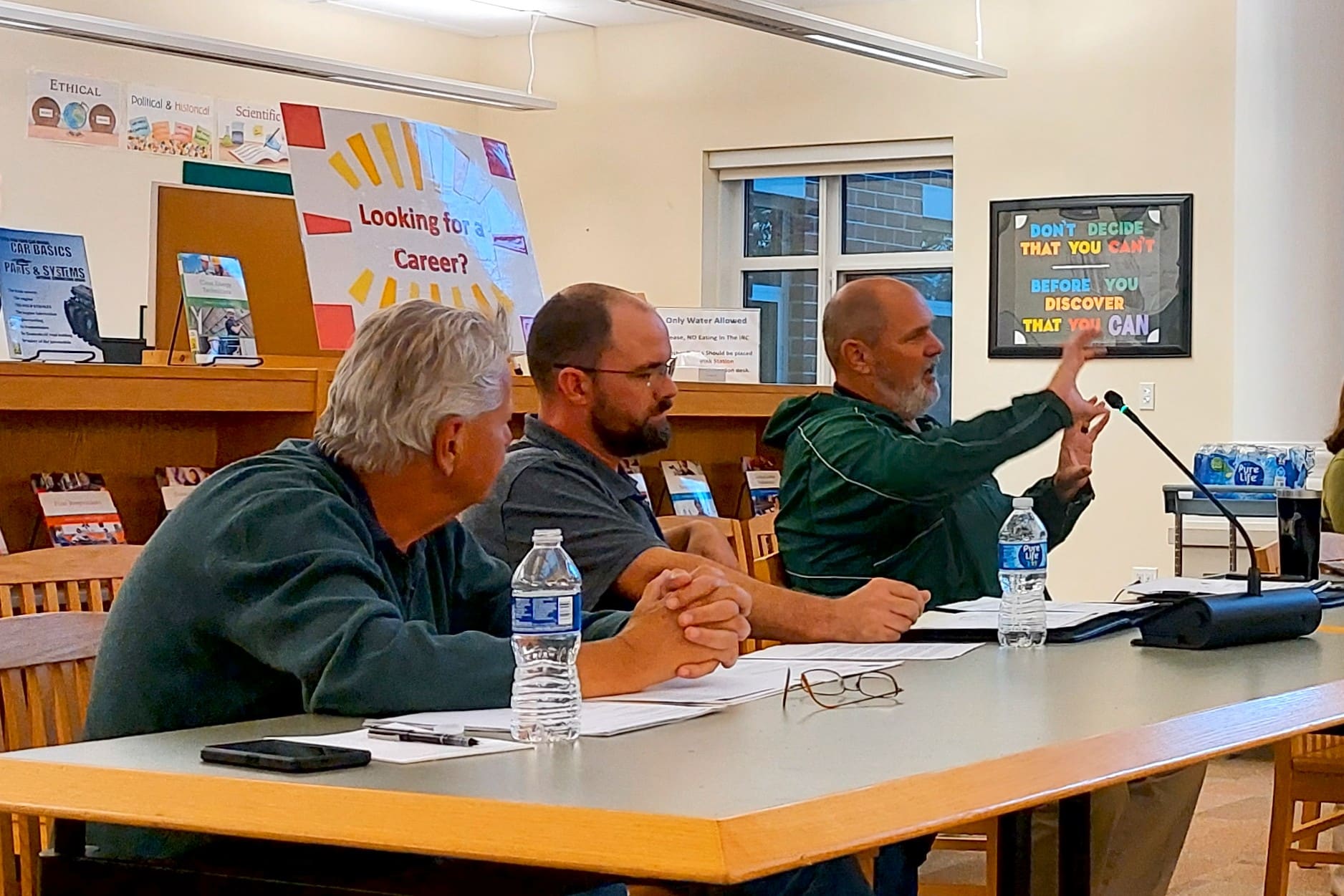Minnechaug Regional High School Principal Stephen Hale described gaps in the bleachers while Director of Facilities and Maintenance Michael Messier and Facilities and Maintenance Manager David Rogers listen.
Reminder Publishing photo by Sarah Heinonen
WILBRAHAM — The Hampden-Wilbraham Regional School Committee discussed the longstanding issue of the bleachers at Minnechaug Regional High School at its Sept. 10 meeting.
Replacing the seating at the football field has been a perennial discussion for a decade, and the project has been postponed many times due to other capital needs.
The district’s plan to seek funding at the Town Meetings in Hampden and Wilbraham was stymied when the latter town decided not to conduct a meeting this fall.
Assistant Superintendent for Finance, Operations and Human Resources Douglas Slaughter said the original project proposed in 2014, which would have used Community Preservation Act funding, was estimated to cost between $590,000 and $745,000. That project included locker rooms under the bleachers and a new concessions stand. An estimate from last year came in at $1.14 million, without any of the amenities of the original plan. Slaughter said inflation was a large factor in the cost increase.
MRHS Principal Stephen Hale clarified that there was “no interest” in bleachers with locker rooms and showers, and that the school was only seeking bleacher seating.
As Hale sees it, there are three issues with the existing bleachers: safety, weight capacity and cost of maintenance. On the issue of safety, he said there is a gap between the seats and the floorboards that poses a risk because children often try to slide through it and climb down.
Director of Facilities and Maintenance Michael Messier said that to be up to code, the gap cannot be more than 4 inches. He estimated the gap on the existing bleachers, built and installed decades ago, to be 18 inches.
School Committee member Michael Tirabassi, a pediatric surgeon, said patients who fall from more than 15 feet are expected to need a trauma room at the hospital. Facilities and Maintenance Manager David Rogers said the drop from the top row of the bleachers is about 20 feet. Tirabassi said the engineer who examined the bleachers and found them to be safe was “100% and completely wrong.” When asked by School Committee member Sherill Caruana about liability, Tirabassi, acknowledging that he is not a lawyer, estimated that the district would be liable for “hundreds of thousands of dollars” in medical bills if someone were to fall from that height.
School Committee member Tim Collins asked if the gaps could be closed. Messier explained that if repairs to the bleachers exceeded 30% of their value, the district would be legally required to bring them up to code and into compliance with the Americans with Disabilities Act.
In terms of weight, Hale said more people come to games and sit on the bleachers than have in the past. An average of 757 tickets is sold for football games. That figure does not include people who are let in free or members of the band. He said, “When you have 100 kids up in that corner, jumping around, I get scared.”
School Committee member Rich Rediker asked if there was a weight capacity on the seating. Rogers said they are rated for about 900 pounds. Hale said the capacity on the new bleachers is 1,294 pounds. Collins said he was relieved to hear the engineer say that the bleachers were “structurally sound” but said that if they were overburdened by weight, the structural integrity is compromised.
Messier explained that the bleachers are maintained regularly. Each summer, about 100 hours of work is spent replacing cracked boards, tightening bolts and fixing any broken pieces. Boards are also replaced as needed throughout the school year.
School Committee member Sean Kennedy asked how much money had been spent repairing the bleachers in the years since the replacement issue was first broached. While Rogers did not have a number immediately available, he said that the district spent $4,719 on boards and hardware in the 2024-25 school year. If the costs were consistent throughout the years, the district would have spent more than $47,000, not including labor.
Tirabassi asked about the cost to maintain new bleachers. Because they are aluminum, Rogers said they only need power washing and to have their bolts tightened.
Kennedy asked what would happen if the school were forced to close off the bleachers due to safety concerns or damage. Hale said there is “not a lot of real estate” for people to set up chairs at the edge of the field. He said it would be difficult to collect tickets if people were seated around the outside of the field. Aside from that, he said game officials do not approve of people sitting behind the goals due to safety concerns. Hale said the media booth at the top of the bleachers would also need to be shut down.
Tirabassi said he was “dumbfounded” that town officials he has spoken to have no interest in replacing the bleachers. He pondered redirecting the athletic revolving account to the Minnechaug Stabilization Account to help pay for the replacement and assess the towns for the items that are usually covered by the revolving account. Hale noted that the profit from some of the games is only in the hundreds of dollars.
Kennedy asked about taking out a loan to pay for the replacement. Slaughter explained that the district must notify the towns that it plans to take on debt. If the towns do nothing, then it is essentially a “pocket approval” and the towns are assessed for the debt service. However, the towns can also choose to call at Town Meeting to vote on whether to reject the planned debt. Borrowing offers the benefit of “sharing the burden across more folks over time,” Slaughter said.
Tirabassi pointed out the irony that Wilbraham will not conduct a fall Town Meeting, but to vote on the bleachers but might need to call one if they do not want to be assessed for the bleachers’ debt.
The School Committee continued the bleachers conversation to its next meeting.



